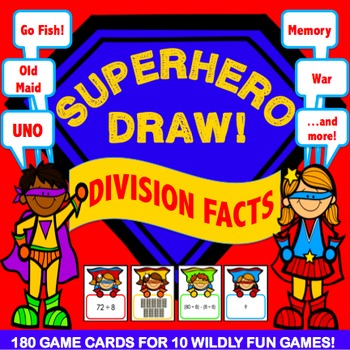Intro to Division With Equal Groups Arrays Printable Basic Division Games Simple
- PDF
What educators are saying
Also included in
- Division Games Division Games Bundle contains 6 different division games and activities to help students practice their basic division skills. Students will have a blast as they practice division in all of these fun and engaging ways! For a limited time, this Division Games Bundle is 20% off thPrice $18.75Original Price $22.00Save $3.25
Description
Make basic division facts practice fun with these Introduction to Division Superhero Draw Games! This exciting resource brings you 10 wildly fun printable division games in one. Students will have a blast playing versions of their favorite card games while practicing simple division facts with equal groups and arrays. Each card game has been specifically adapted for using this basic division cards deck.
There are 144 printable division game cards in this deck. The division facts included are mixed facts from 3s to 10s:
- 36 division sentence cards
- 36 division picture cards showing equal groups or arrays
- 36 distributive property of division cards
- 36 quotient cards
When you purchase this Introduction to Division Superhero Draw Games Pack, you'll receive:
- Directions for playing 10 popular card games adapted for these basic division cards + ideas for fun variations and extension activities
- UNO
- Spoons
- Go Fish!
- Old Maid
- War
- Memory
- Slapjack
- Spit
- Blackjack
- Ranter-Go-Round
- 144 mixed division facts game cards
- 36 'action' game cards for playing UNO and Old Maid
✅ Want to learn more? Check out the preview file above.
Think ahead and save $$ by buying the bundle...
You may also like:
- 3rd Grade Operations No-Prep Math Games Pack
- 3rd Grade Division Facts Math Search Worksheets
- Introduction to Division Digital Practice Slides
- Division Facts 'Squares' Games
- Division Finding the Unknown 'Clip and Flip' Cards
Customer Tips:
We love to hear what you think! Please leave your feedback on this resource to earn credit points to save money on future purchases!
Click on the green ★ above to follow my store to get notifications of new resources, sales, and freebies!
© Games 4 Gains, LLC.
This purchase is for single-classroom use only. Sharing this resource with multiple teachers, an entire school, or an entire school system is strictly forbidden. Multiple licenses are available at a discount.






